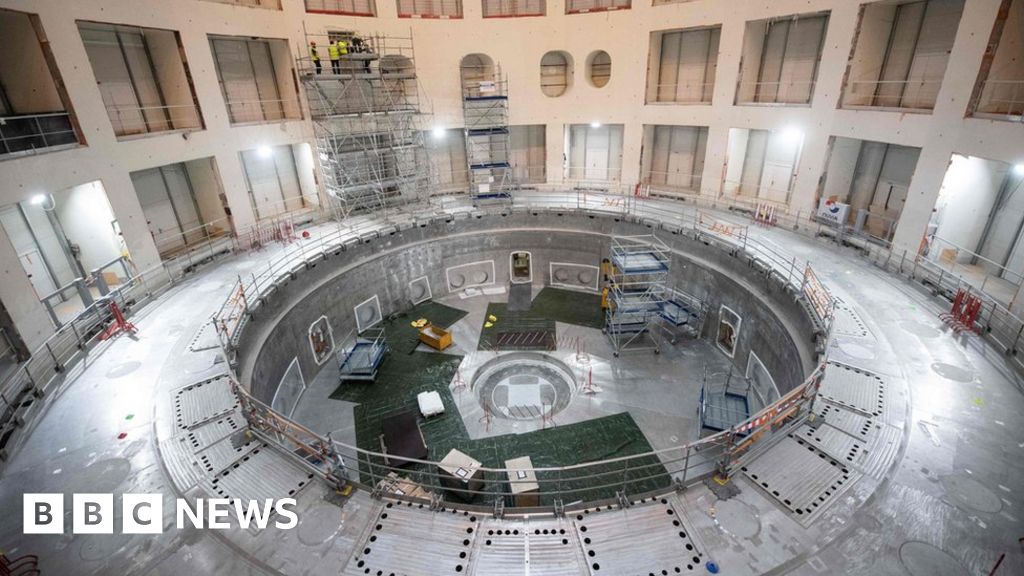
The world's biggest nuclear fusion project has entered its five-year assembly phase.
After this is finished, the facility will be able to start generating the super-hot "plasma" required for fusion power.
The £18.2bn (€20bn; $23.5bn) facility has been under construction in Saint-Paul-lez-Durance, southern France.
Advocates say fusion could be a source of clean, unlimited power that would help tackle the climate crisis.
Iter is a collaboration between China, the European Union, India, Japan, South Korea, Russia and the US. All members share in the cost of construction.
Current nuclear energy relies on fission, where a heavy chemical element is split to produce lighter ones.
Nuclear fusion, on the other hand, works by combining two light elements to make a heavier one.
This releases vast amounts of energy with very little radioactivity.
Iter will confine hot plasma within a structure called a tokamak in order to control fusion reactions.
The project will aim to help demonstrate whether fusion can be commercially viable. France's President Emmanuel Macron said the effort would unite countries around a common good.
The facility could see plasma generated in the machine - a notional start to operations - shortly after the assembly phase ends in 2025.
President Macron said: "Iter is clearly an act of confidence in the future. The greatest advances in history have always proceeded from daring bets, from journeys fraught with difficulty.
"At the start it always seems that the obstacles will be greater than the will to create and progress. Iter belongs to this spirit of discovery, of ambition, with the idea that, thanks to science, tomorrow may indeed be better than yesterday."
Prof Ian Chapman, chief executive of the United Kingdom Atomic Energy Authority (UKAEA), told BBC News: "It's a hugely exciting phase of the project to be in. Most of us came to fusion to change the world - to make a massive difference to how we provide clean energy to future generations. We all know that we need Iter to succeed."
"We hope to see first plasma in five years. That will only be a short plasma - lasting a few milliseconds - demonstrating all the magnets work. Then there will have to be a further stage of assembly of some of the other components... Nevertheless it's ticking off milestones on that path to demonstrating fusion at the commercial scale."
Prof Chapman leads Britain's magnetic confinement fusion research programme at the Culham Centre for Fusion Energy (CCFE), which operates the Joint European Torus, or Jet, research facility. Iter's fusion machine is in many ways a scaled-up version of Jet's.
But fusion power has its sceptics. Making it commercially viable has been difficult because scientists have struggled to get enough energy out of the reactions.
Advocates believe Iter can overcome the technical hurdles and that, given the planetary challenges being faced, fusion is worth the expense and effort.
The UK is a member of the Iter project but is set to fall out, because the British government withdrew from the Euratom treaty as part of Brexit. The UK could stay only if a new way is found to maintain its involvement by the end of the Brexit transition.
But Jet will continue operating for the time being. "We signed a contract with the European Commission to continue operation of Jet last year, which notably doesn't have a Brexit clause in it."
The contract covers experiments next year with deuterium and tritium fuel - the same variants of hydrogen that will eventually power Iter's fusion reactions. Beyond that, Prof Chapman and colleagues are discussing an extension that will keep Jet operating until 2024.
Follow Paul on Twitter.
"world" - Google News
July 28, 2020 at 11:16PM
https://ift.tt/306kNIl
Iter: World's largest nuclear fusion project begins assembly - BBC News
"world" - Google News
https://ift.tt/3d80zBJ
https://ift.tt/2WkdbyX
Bagikan Berita Ini














0 Response to "Iter: World's largest nuclear fusion project begins assembly - BBC News"
Post a Comment